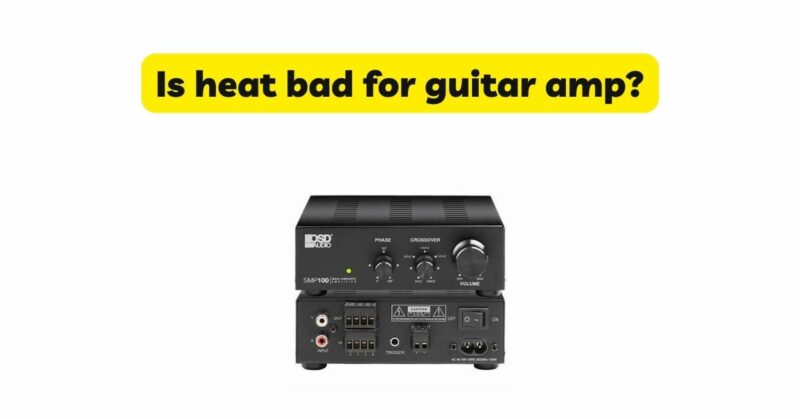Guitar amplifiers are integral components for musicians, shaping their tone and delivering powerful sound. However, heat is a constant adversary that can have adverse effects on guitar amps. In this article, we will explore the impact of heat on guitar amplifiers, discussing the potential consequences of excessive heat, the factors contributing to heat generation, and the measures you can take to safeguard your amplifier from heat-related damage. Understanding the relationship between heat and guitar amps will help you optimize performance, extend the lifespan of your amplifier, and ensure an uninterrupted musical journey.
Heat and Guitar Amplifiers: Unveiling the Dynamics
- Heat Generation in Guitar Amplifiers
Guitar amplifiers generate heat during operation as they convert electrical signals into audible sound. This process involves amplifying the guitar’s signal through the amplifier’s circuitry, which inherently produces heat as a byproduct.
- Factors Contributing to Heat Generation
Several factors influence the heat generated by guitar amplifiers:
a. Power Output and Usage: Amplifiers driven at high volume levels or pushed beyond their rated power capacity generate more heat. Intense playing, such as prolonged high-gain distortion or complex effects, can increase heat production.
b. Amplifier Class and Design: Different amplifier classes, such as Class A, Class AB, or Class D, exhibit varying heat generation characteristics. Inefficient designs or inadequate cooling mechanisms, such as insufficient heat sinks or ventilation, can lead to higher operating temperatures.
c. Tube vs. Solid-State Amplifiers: Tube amplifiers, due to their vacuum tubes, generate more heat than solid-state amplifiers. Tubes require time to warm up, contributing to initial heat buildup, while solid-state amplifiers produce less heat overall.
Effects of Excessive Heat on Guitar Amplifiers
- Component Degradation: Excessive heat can cause damage to internal components, such as tubes, transistors, capacitors, and resistors. Higher temperatures accelerate the wear and tear of these components, leading to diminished performance, increased noise, and potential component failure.
- Tone Alteration: Heat can affect the tonal characteristics of guitar amplifiers. Excessive heat can cause changes in the biasing of tubes or alter the behavior of solid-state components, resulting in tonal shifts, reduced clarity, and increased distortion.
- Reduced Lifespan: Prolonged exposure to high temperatures can significantly shorten the lifespan of guitar amplifiers. The continuous strain on internal components can lead to premature component failure, requiring costly repairs or replacements.
Mitigating Heat-Related Damage
- Adequate Ventilation: Ensure proper airflow around the amplifier by leaving sufficient space and avoiding obstruction. Place the amplifier in a well-ventilated area, away from walls or other heat sources that can impede heat dissipation.
- Cooling Mechanisms: Amplifiers with effective cooling mechanisms, such as fans or large heat sinks, can aid in dissipating heat efficiently. Consider amplifiers that incorporate these features to keep temperatures within safe limits.
- Operating Conditions: Use the amplifier in accordance with the manufacturer’s guidelines. Avoid running the amplifier at maximum volume for extended periods, as it increases heat production. Provide breaks to allow the amplifier to cool down during intense playing sessions.
- Maintenance and Cleaning: Regularly clean the amplifier to remove dust and debris that can accumulate and hinder heat dissipation. Follow the manufacturer’s guidelines for maintenance, including periodic inspection of internal components and cleaning of ventilation openings.
- Transport and Storage: When transporting or storing your guitar amplifier, avoid exposing it to extreme temperatures or direct sunlight. Rapid temperature changes or excessive heat can damage sensitive components.
- Power Management: Utilize efficient power management practices, such as using standby modes or turning off the amplifier when not in use. This reduces unnecessary heat generation and extends the amplifier’s lifespan.
Conclusion
Heat poses a significant threat to the performance and longevity of guitar amplifiers. Excessive heat can lead to component degradation, tonal alterations, and a reduced lifespan. By understanding the factors contributing to heat generation, such as power output, amplifier class, and design, and implementing preventive measures like adequate ventilation, cooling mechanisms, and adherence to operating guidelines, you can protect your guitar amplifier from heat-related damage. Regular maintenance, cleaning, and responsible power management further contribute to optimizing performance and extending the lifespan of your amplifier. By prioritizing heat management, you can ensure consistent tone quality, reliable performance, and years of musical satisfaction from your guitar amplifier.


